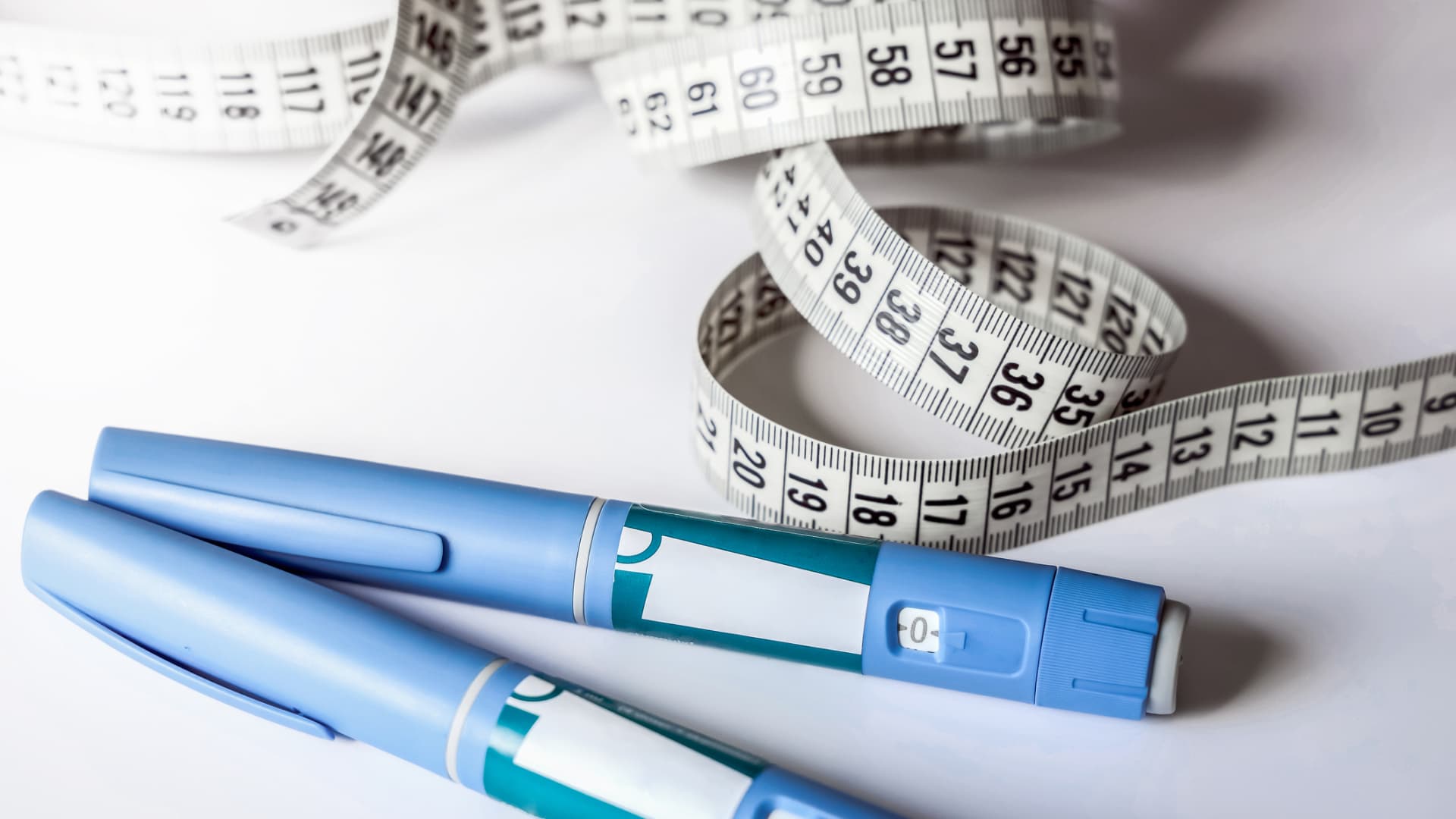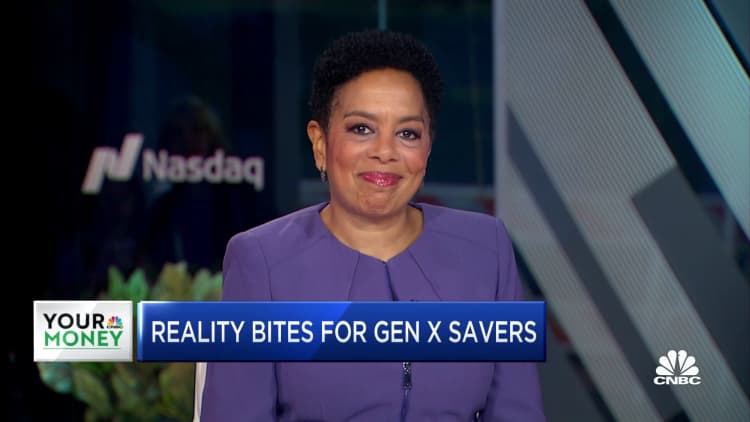Cr | Istock | Getty Images
Biotech company Viking Therapeutics has emerged as a strong potential entrant â or takeover target â in the budding weight loss drug market.Â
Viking is just one of several companies racing to join the growing space. Some analysts say the market could be worth $100 billion by the end of the decade.
Viking aims to compete with injectable drugs from Eli Lilly and Novo Nordisk. Their treatments sparked the weight loss drug industry gold rush over the past year despite their hefty price tags and barriers to insurance coverage.Â
Some Wall Street analysts said Viking’s experimental obesity treatment may be “best-in-class.” In a midstage trial, an injectable version of Viking’s drug appeared to promote even greater weight loss than Eli Lilly’s Zepbound.
Viking gave a first glimpse at data from that study on Tuesday, and its shares soared 120%. The promising results make the company an impressive potential player in a market that will likely have room for more entrants in the coming years.Â
Goldman Sachs projects that between 10 million and 70 million Americans will be taking weight loss drugs by 2028. Eli Lilly and Novo Nordisk have also struggled to offer enough supply of their treatments, giving other companies a chance to win market share. Â
The new data also makes Viking a more attractive deal target for larger companies trying to break into the space or expand their obesity treatment offerings.
It’s too early to say whether Viking’s drug could have an edge over existing or developing weight loss treatments. It’s difficult to compare therapies without pitting them head to head in the same clinical trial.Â
Viking also needs to conduct a late-stage study on its drug, and likely won’t launch the injection until the later part of the decade. The small company faces hurdles to entering the market, such as manufacturing enough of the drug to meet booming demand. But an acquisition by a larger company could help solve some of those issues.
Data suggests Viking’s drug may have an edge
Viking’s phase two trial followed more than 170 patients who are overweight or obese. They received different dose sizes of the injectable drug or a placebo.
The trial did not directly compare Viking’s treatment to other drugs. Still, many analysts compared Viking’s injection to Eli Lilly’s Zepbound, largely because they work the same way.Â
An injection pen of Zepbound, Eli Lillyâs weight loss drug, is displayed in New York City on Dec. 11, 2023.
Brendan Mcdermid | Reuters
Both drugs imitate two naturally produced gut hormones called GLP-1 and GIP. GLP helps reduce food intake and appetite. GIP, which also suppresses appetite, may also improve how the body breaks down sugar and fat.
Meanwhile, Novo Nordisk’s weight loss injection Wegovy only targets GLP-1.Â
Analysts were particularly impressed by the weight patients lost after they took the highest dose of Viking’s drug. Those who received a weekly 15 milligram dose of the treatment lost 13.1% of their body weight on average after 13 weeks compared to those who took the placebo.Â
Notably, there was no evidence of a plateau in weight reduction at week 13 for any dose of the drug. That suggests that “further weight loss might be achieved” by keeping patients on the treatment longer, Viking CEO Brian Lian said during a call with investors on Tuesday.
Viking’s drug data shows a “best-in-class profile” among both approved and experimental weight loss drugs with phase two trials, William Blair analyst Andy Hsieh wrote in a note Tuesday. Eli Lilly’s Zepbound generated roughly 7% weight loss relative to a placebo after 12 weeks in a phase three clinical trial, Hsieh noted.
Viking’s drug also appears to top Novo Nordisk’s weight loss injection Wegovy, according to a separate Tuesday note from BTIG analysts.
Based on chart data from a phase three trial, the analysts estimated that Wegovy caused around 5% weight loss at 13 weeks compared to a placebo.
Meanwhile, several analysts estimated that some doses of Eli Lilly’s experimental injection, retatrutide, caused between 9% and 13% weight loss relative to a placebo at 13 weeks based on chart data from a midstage trial.
The majority of adverse side effects that patients experienced after starting Viking’s drug were mild or moderate. Many of those instances were gastrointestinal, which is common across all weight loss and diabetes treatments.
Around 20% of patients who took the 15 milligram version of Viking’s drug discontinued treatment early in the study. That compares with around 14% of those taking the placebo who stopped early in the trial.Â
But Jefferies analyst Akash Tewari wrote in a note Tuesday that Viking’s trial used faster “titration” in patients. That refers to increasing the dose size a patient takes over time until they reach a target dosage level.Â
He said Viking may be able to make its drug easier for patients to tolerate in a future trial with slower titration, which could potentially lower the treatment’s efficacy.Â
Viking still has a long way to go
Despite the compelling data, Viking has far more work to do before it can compete in the weight loss drug market.Â
The company plans to meet with the U.S. Food and Drug Administration later this year to discuss a clinical development plan for the treatment.Â
Viking CEO Brian Lian told investors on a call Tuesday that the company will likely conduct another phase two trial that could last six to nine months.
Jefferies’ Tewari estimates that Viking’s treatment won’t reach the market until 2029 or later. A late-stage trial on the drug could be lengthy. Eli Lilly’s phase three study on Zepbound lasted two and a half to three years.
The late entrance of Viking’s drug is one reason why Tewari doesn’t believe the company will meaningfully cut into Eli Lilly’s market.
The pharmaceutical giant could also launch a slate of other weight loss treatments over the next few years that may have advantages over Zepbound, whether they offer more weight loss or convenience. They include Eli Lilly’s experimental pill orforglipron and the widely watched retatrutide, which mimics three gut hormones instead of two.Â
An Eli Lilly and Company pharmaceutical manufacturing plant is pictured in Branchburg, New Jersey, on March 5, 2021.
Mike Segar | Reuters
Analysts from Deutsche Bank added in a note Tuesday that manufacturing the treatments “at scale to meet outsized demand has proven to be no easy feat.” They said that gives Eli Lilly and Novo Nordisk a “defensive moat” against rivals.
Viking acknowledged this hurdle on the call Tuesday. Lian said the company has enough supply of the drug to support its clinical trials, but its manufacturing capacity is insufficient for a commercial rollout.Â
But Lian noted that the company is “spending a lot of time” evaluating multiple manufacturing processes to understand “what’s fastest, what’s highest yielding, what’s cheapest and what’s most scalable.”Â
Partnerships, buyouts are on the tableÂ
Viking’s impressive data could make it an attractive target for a takeover or partnership with a large pharmaceutical company. That could give Viking the commercial and manufacturing capabilities needed to compete in the weight loss drug market.Â
William Blair’s Hsieh added that large pharmaceutical companies could maximize the value of Viking’s treatment because they could better navigate the rebate and reimbursement landscape for weight loss drugs.
Some analysts expect other companies to have high interest in Viking.
“This very well could be on the shopping list for any large-cap pharma or biotech company that wants to be in the obesity market but currently doesn’t have a drug. There are plenty of them out there,” Oppenheimer analyst Jay Olson told CNBC.Â
He added that a company could “pay a pretty significant premium for Viking and pick this up ⦠for a relatively low price compared to the potential that exists for a drug like this.” As of Friday, Viking had a market cap of more than $8.5 billion.
Injection pens of Novo Nordisk’s weight loss drug Wegovy are shown in this photo in Oslo, Norway, on Nov. 21, 2023.
Victoria Klesty | Reuters
Viking is an appealing deal target because of more than just the new data. Wall Street is eager for the company to release early-stage trial results on an oral version of its weight loss treatment this quarter.Â
The BTIG analysts noted that the intellectual property coverage for both versions of the drug extends beyond 2040, “boding well” for potential partnership discussions.Â
Viking also has other drugs in development, including a promising oral treatment for a certain form of liver disease. Eli Lilly, Novo Nordisk and other drugmakers are also racing to see whether their drugs can treat that same condition.Â
Viking hasn’t disclosed any details about its discussions with potential partners. But the company has “always been open to partner discussions since day one, so we’re always opportunistically evaluating whatever is presented to us,” Lian said during Viking’s fourth-quarter earnings call last month.Â
Other drugmakers have pursued deals over the past year to carve out a space in the weight loss drug market.Â
Swiss company Roche said it would buy the privately held U.S. obesity drugmaker Carmot Therapeutics for $2.7 billion. AstraZeneca signed a licensing agreement with Chinese biotech company Eccogene to develop an obesity pill.Â
Even Novo Nordisk and Eli Lilly have snapped up smaller obesity drug companies this year to maintain their dominance in the market.
Don’t miss these stories from CNBC PRO:







